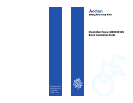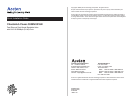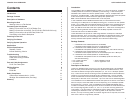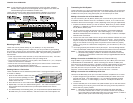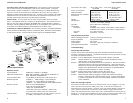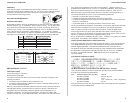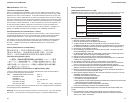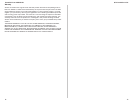
Quick Installation GuideCheetaHub Power-3008N/3016N
1
Contents
Introduction 1
Package Contents 1
Description of Hardware 1
Mounting the Hub 2
Stacking Hubs on a Flat Surface 2
Connecting the Hub System 3
Making a Connection via an RJ-45 Station Port 3
Making a Connection to the BNC Port (EH3016N, EH3016N-SW only) 3
Making a Connection via an MDI Daisy-Chain Port 3
Connecting to the Stacks Backplane 4
Powering On the Hub 4
Verifying Port Status 5
Verifying System Operation 5
Applications 5
Product Specifications 6
Repeater Criteria 6
Internal Switching Criteria 7
Troubleshooting 7
Diagnosing Hub Indicators 7
Power and Cooling Problems 7
Installation 8
Port and Cable Assignments 8
RJ-45 Port Description 8
EMI Certification 8
EH3008N 8
EH3016N 10
Safety Compliance 11
Underwriters Laboratories Inc. (USA) 11
Wichtige Sicherheitshinweise (Germany) 11
Warranty 12
Introduction
The CheetaHub Power-3008N/3016N provides 8 (or 16) RJ-45 ports for 10 Mbps or
100 Mbps Ethernet connections (detected by auto-sensing). These dual-speed
stackable hubs contain two internal repeater buses one for 10 Mbps traffic and
another for 100 Mbps traffic. Traffic passing between attached devices that operate
at the same speed is confined within the appropriate repeater bus.
Note: The EH3016N/SW also includes a BNC on the rear panel.
In the CheetaHub Power-3008N-SW/3016N-SW, an internal Ethernet switch,
consisting of a 10 Mbps and a 100 Mbps switching port, is used to link the repeater
buses. Only if traffic has to be passed between a 10 Mbps and a 100 Mbps device,
if the destination address is not found in the address table, or broadcast traffic is
sent, will data be forwarded to the other repeater bus. These hubs are designed to
perform switching between the 10 Mbps and 100 Mbps repeater buses for the
individual hub and for the attached stack.
These stackable hubs provide an ideal bridge between 10 Mbps and 100 Mbps
Ethernet networks, all for a price that's comparable to a standard Ethernet or Fast
Ethernet hub. Moreover, the smart design built into the display panel provides a
friendly interface that simplifies installation and network troubleshooting.
Package Contents
CheetaHub Power-3008N (Model No. EH3008N)
Fast Ethernet dual-speed hub with 8 10/100 Mbps ports
or CheetaHub Power-3008N (Model No. EH3008N-SW)
Fast Ethernet dual-speed hub with 8 10/100 Mbps ports; with internal switching
or CheetaHub Power-3016N (Model No. EH3016N)
Fast Ethernet dual-speed hub with 16 10/100 Mbps ports and 1 BNC port
or CheetaHub Power-3016N (Model No. EH3016N-SW)
Fast Ethernet dual-speed hub with 16 10/100 Mbps ports and 1 BNC port;
with internal switching
Four rubber foot pads Quick Installation Guide
Hub stack cable Owner registration card
AC power cord
Description of Hardware
These four stackable hubs provide 8 (16) RJ-45 dual-speed ports (10/100 Mbps).
Each of these ports automatically senses the speed of the attached device, and
channels the data to the appropriate backplane (i.e., the 10 or 100 Mbps repeater
bus). Hubs with the internal switching function (EH3008N-SW and EH3016N-SW)
contain a 2-port switch that connects the two repeater buses. The two repeater
buses are extended across the stack backplane (via the cable connection to the
stack ports) to the other hubs in the stack. Up to six hubs can be stacked together.
The CheetaHub Power-3008N/3016N detects the speed of the device connected to
each RJ-45 port, and directs traffic to the corresponding 10 or 100 Mbps repeater
bus as required. However, when a CheetaHub Power-3008N-SW/3016N-SW is
included in the stack, the learning function of this hub stores the node address and
the correponding segment number (i.e., bus 1 or 2) of each incoming packet in a
routing table. This information is subsequently used to pass traffic to the segment
containing the destination node. By confining traffic to its respective collision
domain, and only forwarding traffic to the other segment when required, the overall
load on the network is significantly reduced.



